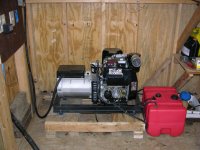BobRip
Elite Member
Highbeam said:It seems to me that the best place for a transfer switch is between the meter and the main breaker panel. That way you can run any appliances you want and shut off power to any circuit you want through the standard breaker. These sub planel transfer switches include a lot of hokey wiring above and beyond the normal spaghetti maze. The problem is that the meter backs right up to the breaker panel in many installations including my home leaving nowhere to splipce in a TF.
Am I missing an important point?
I would like to know how to legally and safely power up my house with my big honkin loud 220 generator and since the only big appliance I have is my clothes dryer there is no reason that the generator can't fully replace grid power.
The next question is that my generator is marked as having a "floating" neutral. Are you all tying the generator to ground and using all 4 wires of the typical generator 4 prong twistlok? Or just using the two hots, the white neutral and no generator ground?
If your service is 200 amps or less, there is a transfer switch that goes between the meter and meter base. Dominion Power sells this. It is probably exactly what you are looking for.




